|
Memphis
Ellis Auditorium
|
AKA Memphis
Auditorium and Market House |
|
|
|
Ellis Auditorium was located in downtown Memphis on the corner of Poplar and Front Street.
The completion of the Auditorium in 1924 made Memphis
one of the first cities in the nation to offer comprehensive meeting and
convention facilities. The auditorium was way ahead of its time,
offering 30,000 square feet of
display space and seating for 12,000. It even featured a movable stage that was entirely
electric. A period brochure boasted that the mechanical marvel took
only 12 hours to move! The auditorium was so advanced, it would
be 50 years before a new facility was needed.. |
 |
| |
|
|
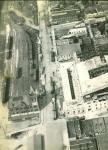 |
Memphis saw a
building boom beginning in 1920, with many new buildings going
up. George Awsumb
designed plans for a new auditorium and it was built not long
afterwards at the North End of Front Street. When it
opened, Memphis finally had a venue for Opera, Exhibitions,
and large theatrical productions. Promoters hyped its
removable, hardwood floor ('unexcelled for dancing") and its
connections for steam as well as for hot and cold water.
The original name for the structure was
"Memphis Auditorium and Market House". It was a
combination athletic arena, concert hall, convention center,
and retail produce market. Apparently, Memphis city
fathers didn't believe income from the entertainment halls alone would sustain the
$3,000,000 investment, and during the first ten
years of operation, the rental income from the market stalls
actually earned more money than the rental of the hall for
entertainment purposes..
|
|
Construction 1924 |
|
|
|
- Click on small photos
to see enlargements - |
| |
|
|
|
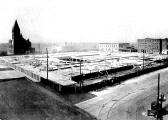 |
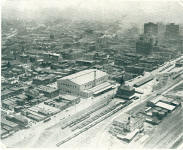 |
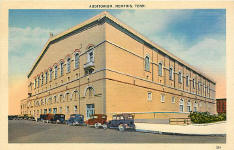 |
 |
|
Foundation 1923 |
New
Auditorium 1920s |
Postcard 1930 |
Demolition 1999 |
| |
|
|
|
|
|
The
moving force behind the auditorium was Robert R. Ellis and
after his death in 1930, the facility was renamed for him.
However the
major drive behind the construction of the building was mostly economic.
Memphis had already become a
significant distribution center by the 1920s. Many railroads
and truck lines, along with the Mississippi River, made
it one of the most accessible cities in the country.
Business and government leaders of the time wanted to make the
city a great place for conventions.
When the new auditorium was dedicated in 1924,
John Philip Sousa was the opening
act. From this beginning and throughout
its lifetime, Ellis
hosted circuses, opera, symphony concerts, trade shows, movies,
traveling theatrical shows, conventions, and big bands. In
segregated Memphis, Blacks had a separate side entrance at the
Auditorium and sat in a separate balcony. (The Harlem
Globetrotters set record sales of more than 6,000 'white' tickets in
1953).
|
| |
 |
 |
 |
 |
 |
 |
 |
|
Sousa |
Hepburn |
Martin |
Rachmaninoff |
Duncan |
Presley |
Barrymore |
|
| |
|
Ellis Auditorium brought such legendary performers as
Katharine Hepburn, Mary Martin, the Russian composer Sergei
Rachmaninoff, and dancer Isadora Duncan to Memphis. This
was also the
Auditorium where Elvis first played to a sold out
crowd. Almost all Memphis High School
graduations were held here. Numerous touring productions
also appeared, including the John Barrymore touring company. Barrymore’s alcoholism made
every performance a test of nerves; he would skip lines,
demand to see cue cards, or treat the play as a joke.
And there were the six decades of Memphis music that filled the halls.
That's sixty years of Memphis music. |
|
|
|
 |
George
Awsumb (1880-1959) was the architect for Ellis
Auditorium. He was born in Norway, emigrated to the U.S. as a
child, and reared in Wisconsin.
Soon after winning the
competition in 1919 for the Memphis Municipal Auditorium,
Awsumb moved to Memphis from Chicago, where he had been a
successful architect. In partnership with Charles O. Pfeil, the
final auditorium design and construction was completed, as
well as the plans for Humes (1926) and Southside (1927) High
Schools and Idlewild Presbyterian Church (1929). The firm was
also responsible for designing the Dermon Building(1925) and
the 1948 Baron Hirsch Synagogue. |
| |
|
|
 |
Robert R.
Ellis
(1878 -1930)
was President of the Memphis Chamber of Commerce who
spearheaded the Auditorium project at the request of Boss Ed
Crump. He was born in West Point, Mississippi, became a
trained Pharmacist and drug store owner who moved to Memphis
and founded the Ellis-Hessig Wholesale Drug Company. Later a
merger with Van Vleet Drugs soon become Van Vleet-Ellis Drugs,
Inc. His civic leadership was so well recognized, he was
elected Vice-President of the U.S. Chamber of Commerce; a
position he held until his untimely death at age 52.
After his death in 1930, the Auditorium
was renamed 'Ellis Auditorium' in his honor. |
|
|
|
|
 |
Charles A. McElravy
(1878 - 1961)
was General Manager of Ellis Auditorium from its opening in
1924 until his retirement in 1951. His many responsibilities
included booking the talent, drafting the contacts, insuring
each shows success, etc. The Auditorium was profitable the
last 22 of his 27 year career. McElravy died in 1961.
In his honor, 'The Charles A. McElravy Award' was created in
1963, honoring the International Association of Auditorium
Managers pioneer and citing current members "for contributions
to the IAAM and the profession of auditorium management."
It is a very prestigious International Award.
Click here
to read an article by Charles McElravy, summing up his
years in the business. Published in Billboard
Magazine in 1951. |
|
|
|
|
 |
David Richard Williams (1863 - 1936)
The first Ellis Engineer. Williams began his career as
engineer for Chickasaw Cooperage Co, and then became Chief
Engineer for the Gayoso Hotel, where he installed a large plant.
Afterwards he went to Chicago as Chief Engineer for a major
hotel as well as in charge of the Machinery Hall for the 1893
World's Fair. In 1925 when the Auditorium opened he
returned to Memphis as Chief Engineer. At the time of his
death he had been the electrical expert with more than 22
leading hotels in the US and Australia.
Click here
for David Williams 1936 Obit. |
|
|
|
|
During 1956-57
Ellis was remodeled-updated and a new entrance was
added in the early 1960s. In 1974 the Cook Convention Center
was built adjacent to the auditorium. But the city no longer
properly maintained old Ellis. The
plaster began chipping off the ceilings. The electrical and
mechanical systems became outdated. The auditorium's North and
South Halls had been neglected for so long that the Convention
Center Board of Directors decided that renovation was no longer
an option. |
| |
 |
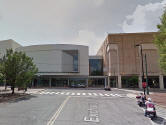 |
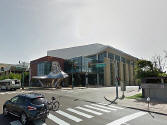 |
|
New Entrance in the 1960s |
1974 Cook Convention Center |
2003 Cannon Center for Performing Arts
|
|
|
|
After 75 years of continuous entertainment, Ellis was razed in July of
1999 for the expansion of the Cook Convention Center and to make way for the
new Cannon Center for Performing Arts which opened in January
2003. Prior to the implosion of the old building,
architectural terra cotta pieces from the nautical design of
the building were salvaged and sold to collectors. The
last performance at Ellis was Bruce Springsteen, November
1996. |
| |
|
|
| |
<> |
|
|
Just when you thought you knew everything about the old
auditorium... |
| |
|
|
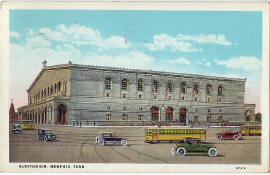 |
Ever wonder
why Ellis had a Poplar Street address instead of a North
Main address? Ever wonder why there was extra
frontage on Main Street that was never used? That
extra frontage clearly shows in the dedication photos
taken in 1924. Well...
< This vintage
postcard, mailed in 1931, is an illustration, which shows porticos on both sides of
the auditorium. These porticos were not on the
building when it opened in 1924 and they don't show in
the "under construction" photo above. This
partially explains why the auditorium had a Poplar
Street Address. But there was still that unused
extra frontage on Main Street, which always seemed
like an "after-thought". |
|
| |
|
|
|
During
research, we learned that in 1924, the United
Confederate Veterans held their annual convention
at the new Auditorium on June 4-6, 1924, four and
one half months BEFORE it officially opened.
Those Confederate veterans at the convention were issued
badges. Take a close look at their badges.
>
On the badge is an equestrian statue of Nathan
Bedford Forrest and, of course, the Confederate flag.
But at the top |
 |

|
 |
 |
|
is an
engraving of the new auditorium building, which clearly
shows the two side porticos that appear in the postcard
above. |
|
 |
But wait! It
also shows a great extension and Grand Entrance on the Main Street side - just where
that extra frontage is located. The badges
were obviously made in advance of the convention and were based on the architect's drawings.
Sometime between those drawings and the construction, a decision was
made to eliminate the side and front porticos - perhaps
due to cost overages. Because of these
badges, we now know what was originally planned for the
Auditorium - or what might have been. It answers some
questions but opens up a lot more.
|
|
Main
Street Grand Entrance |
- Thanks to
Dave French for discovering the Postcard and the Badges |
|
|
|
From these
architect's drawings (below), published in 1919 and
1923, we've now learned that the North and South
Porticos were still part of the auditorium design, but
the Grand Entrance on Main Street had already been
eliminated before construction began on the building.
Click on the photo to see the drawing as it appears in
the 1923 article about major musical talent being booked
into Memphis during the 1923 season. |
|
|
|
|
|
|
 |
 |
|
|
1919 Architect's Drawing |
1923 Architect's Drawing with North-South Porticos
- No Grand Main Entrance |
|
|
|
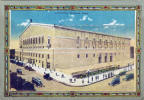 |
 |
< Two very revealing
Postcards. The postcard on the left is from
1925-26 and shows the finished Auditorium - minus the
North and South Porticos and with that "extra
frontage" on Main. The card on the right is from
1920 and is obviously an artist's rendering. It
shows the planned North and South Porticos and a Grand
Entrance on Main which would exactly fit that "extra
frontage" on Main. Did the city plan to add this
Grand Entrance later? |
|
Main Street extra frontage - 1925s |
1920 - Artist's Rendering Postcard |
|
|
|
|
|
The final
chapter actually found us in August of 2012, when
we received the 50 page booklet "The Story of the Memphis
Auditorium" from the "Greater Memphis Chamber". In the booklet we learned
that the grand front portico on the Main Street side
was
actually meant to be City Hall. So our Auditorium
was originally planned as a combo-building - Auditorium-Market Place-City Hall. That might have happened
if the construction hadn't taken so long (partially due
to WWI). Before the architect's plans were finally
agreed upon, it was already certain "that the funds
available would not be sufficient to provide quarter for
officials of the city, without detracting from the
appearance and conveniences of the auditorium proper.
The Commission therefore abandoned the city hall plan
and instructed the architect to revise his building
plans in such a way that quarters for city
administration might be added in later years if deemed
advisable". |
|
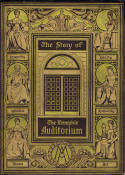 |
 |
|
1926 Booklet Cover: Story of Memphis Auditorium |
|
|
|
|
|
The same was
true of the porticos on the north and south sides of the
building "...will adequately perform the function
suggested by the designer, but may, if lack of funds demand,
be omitted without serious detriment to the architectural
beauty and utility of the building". So that front
foundation on Main was "available" if the city ever found
funds to add their City Hall and the north and south porticos
were simply omitted all together. In the meantime
Memphis submitted the architects original auditorium drawings
to the United Confederate Veterans who simply used them in
designing the medals for their 1924 Reunion. Plus the
city was apparently so proud of their grand plan that they
submitted the same drawings to postcard manufacturers.
Click on the Program Cover
(above)
to see and read the entire booklet "Story of the Memphis
Auditorium" |
|
|
|
|
|
August 2013
Update. Once again when we thought we knew it all:
This
very rare medal for the 1930 Memphis Convention of
the Tent and Awning Manufacturers
(on the right)
was discovered on eBay by Historic-Memphis.com team
member Dave French. The convention was held at
Ellis and that original design for the auditorium with
the North, South Porticos, and the Grand Entrance on
Main is still used on this medal 6 years after the
auditorium opened. It brings up more questions
than answers: Did the convention organizers go to
the same medal design company that the UCV had used? Did
the City of Memphis furnish the original design drawing
to the Tent-Awning Manufacturers by mistake? Did
the City of Memphis still have plans to build that Grand
Entrance? > |
 |
| |
|
|
|
Another
Update ... September 2013:
This medal for
a 1940 Shriner's Convention
in Memphis was recently found on eBay by Dave French.
Once again it continues to show that original design for
the auditorium with the North, South Porticos, and the
Grand Entrance on Main, which is still being used on a
medal 16 years after the auditorium opened. We
continue to have those unanswered questions and we will
continue digging until we have the answers.
> |
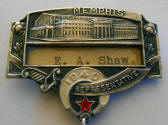 |
 |
|
|
|
|
|
| |
|
|
|
|
|
| Ever
wonder what was on the Auditorium site before Ellis was built?
The Overton Hotel
opened on the corner of Poplar and Main in 1866 and was used
by both sides during the Civil War. The Grand Duke of
Russia stayed here in 1872. In 1874 it was sold to
Shelby County and was used as a Courthouse until 1919.
When the city purchased the building, they knocked off the top
floor but left the two front corner sections as "towers".
The historic building was demolished and Memphis Ellis
Auditorium was built on the site in 1924. |
 |
| |
Shelby County Courthouse |
| |
|
|
|
The historic Ellis
Auditorium lives on through the collection of photos, publications,
and memorabilia posted below.
Special thanks to the
Memphis Public Library
for many of the photos on this page. |
|
|
|
|
|
|
Memphis
Auditorium and Market House
Interior Photos |
| |
|
|
|
 |
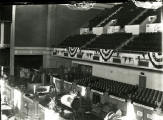 |
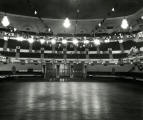 |
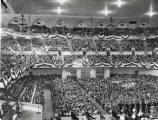 |
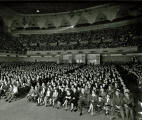 |
|
1926
Market |
North Hall
Market |
North Hall
1926 |
North Hall |
Ellis South Hall 1944 |
| |
|
|
|
|
 |
 |
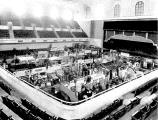 |
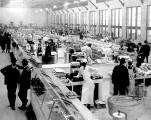 |
 |
|
Auditorium Market |
Auditorium Market |
Market 1924 |
Market c. 1924 |
5000 at Gospel
Concert |
| |
|
|
|
|
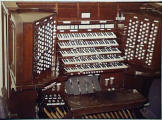 |
 |
 |
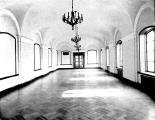 |
 |
|
Kimball Organ
|
Smaller Organ |
Organ Pipes |
Committee Room c 1924 |
Entrance c. 1924 |
| |
|
|
|
|
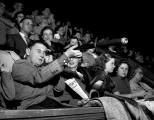 |
|
|
|
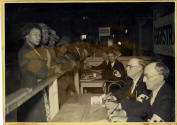 |
|
Ellis - 1954 |
|
|
|
1937 Flood
Refugees
|
| |
|
|
|
|
|
|
| |
|
|
|
| |
|
Vintage
Photos of the Performers ... |
| |
|
|
|
|
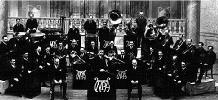 |
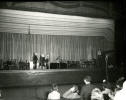 |
 |
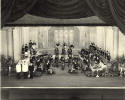 |
|
WPA Band 1930
|
Radio Show
1944 |
CBC Band
1948 |
CBC Band 1949 |
| |
|
|
|
|
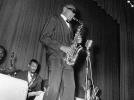 |
 |
 |
 |
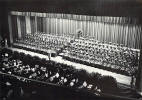 |
|
Ray Charles 1961 |
Agnes
Moorehead |
Van
Cliburn 1972 |
James
Brown 1961 |
'61
Kingsbury Graduation |
| |
|
|
|
|
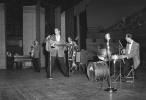 |
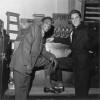 |
 |
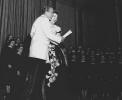 |
 |
|
Elvis 1956
|
Benton-Elvis '57 |
Elvis 1955 |
Ed
Sullivan Show '53 |
Marguerite Piazza 1953 |
| |
|
|
|
|
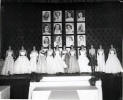 |
 |
 |
 |
 |
| Maid of Cotton 1954 |
Maid of
Cotton 1962 |
Brown-Day-Hope '48 |
Day-Hope
'48 |
Blackwood Brothers |
| |
|
|
|
|

 |
 |
 |
 |
 |
 |
|
Preston-Martin
Nureyev
|
Hendrix
1969 |
Passion
Play '52 |
Passion
Play '52 |
Elvis-BB King '56 |
Gorgeous George |
|
| |
|
|
|
|
 |
 |
 |
 |
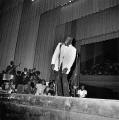 |
|
Elvis 1962 |
Elvis 1956 |
Steve
Martin 1978 |
Liberace
1954 |
Howlin Wolf 19600 |
| |
|
|
|
|
 |
 |
|
 |
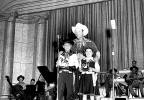 |
| Dylan 1966 |
Elton John
1971 |
|
Jack Benny 1973 |
Roy Rogers 1950 |
| |
|
|
|
|
| |
|
|
|
|
|
|
|
|
|
|
Ellis Auditorium
Memorabilia |
|
| |
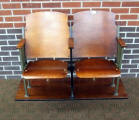 |
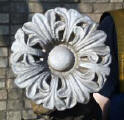 |
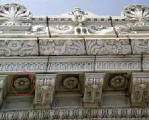 |
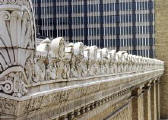 |
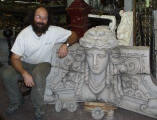 |
|
Ellis Seats
|
Roof Decor |
Roof Decor |
Roof Decor |
Roof Decor |
| |
|
|
|
|
 |
 |
 |
|
 |
|
Roof Decor |
Els |
David Bowie 1972 |
|
Elvis 1961 |
| |
|
|
|
|
 |
 |
|
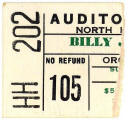 |
 |
| Mazie Dimond
and mural |
Organ-Today |
| Cheap Trick'79 |
C. '49-'50 |
|
Billy Joel 1974 |
Elvis 1956 |
|
|
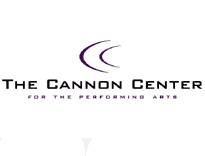 |
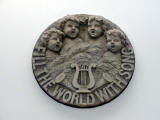 |
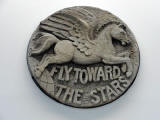 |
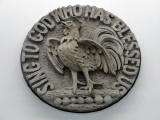 |
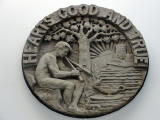 |
|
These 9 terra-cotta architectural ornamentation medallions
from Ellis now hang at the Cannon Performing Arts Center. |
| |
|
|
|
|
 |
 |
 |
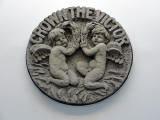 |
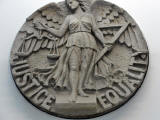 |
|
These 9 terra-cotta architectural ornamentation medallions
from Ellis now hang at the Cannon Performing Arts Center. |
| |
|
|
|
|
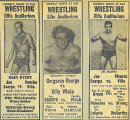 |
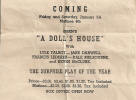 |
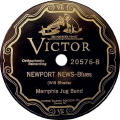 |
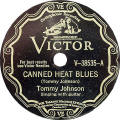 |
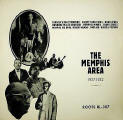 |
|
Wrestling Ads |
Flyer: Doll's House 1945 |
Recorded
at Auditorium: Jug Band 1927 -Tom
Johnson 1928 -The Memphis Area 1927-32. |
|
|
 |
|
|
 |
| 1930
Ad for "Cherries are Ripe" |
|
NGDB '76 |
Steve Martin '75 |
|
DaveMason '70 |
Dolphin Decor |
|
|
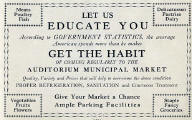 |
 |
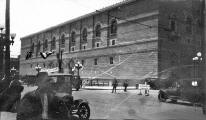 |
|
Market Ad - 1925's |
1927 "Convention
City" License plate |
First photo ?? -
1924 |
|
|
|
|
 |
|
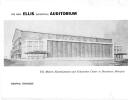 |
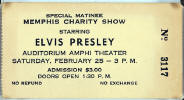 |
| 1934
Grace Moore Reviews |
Colonel Memphis |
|
"New"
Flyer c. 1960s |
Elvis
Charity Event 1961 |
|
|
|
 |
 |
 |
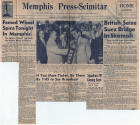 |
 |
 |
|
Sousa 1924
|
1937
Ticket |
Press Scimitar "Amateur Hour" Articles -
1951 (BIG FILES) |
Amateur Hour 1951 |
Ernestine Lomax
wins. 1951 |
|
|
|
 |
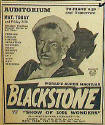 |
 |
 |
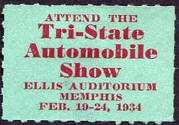 |
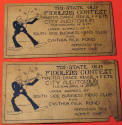 |
| 1960 Ad |
Blackstone
1946 |
Wrestling 1968 |
Wrestling 1968 |
Auto Show 1934 |
RARE:
1925 Tickets |
|
|
|
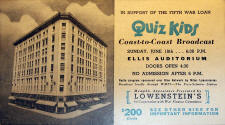 |
|
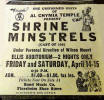 |
|
 |
| 1944 Quiz Kids
Ticket |
|
1967 Minstrels |
|
Springsteen
Pass 1978 |
|
|
|
|
|
|
|
|
| |
|
1957-1960s
Ellis is "new"
again
Old Ellis was finally remodeled and updated over a
several year period from 1956-early 1960s. There are no
exact dates because it was "business as usual" during
the remodel. The upgrades included the addition of
escalators, plus new lighting and new sound equipment.
But the major improvement was a "Sound Curtain". When
this was lowered, it allowed two different events to go
on at the same time in the two different halls - newly
named "Music Hall" and "Amphitheatre".
The improvements are described in the Billboard
article and the Brochure published by the Memphis
Chamber of Commerce.
Click on the Brochure Cover to
see the entire Brochure
|
|
 |
|
1956 Billboard |
|
|
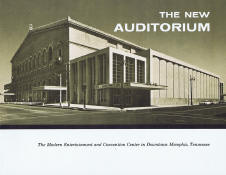 |
|
 Brochure
Cover
Brochure
Cover |
|
|
|
|
Note:
True to Memphis' inclination toward name
changes, the "Music Hall" name was later changed to
DeFrank Hall and the "Amphitheatre" name was later
changed to Dixon-Myers Hall. |
|
|
|
|
| |
|
|
|